Shep Hyken's Blog, page 88
March 19, 2021
Guest Post: Brilliant Advice for Women Breaking into CS Leadership Roles
This week we feature an article from Kaila Krayewski, Managing Director at Archipelago Communications. She introduces a few female customer service speakers and shares their advice for women pursuing leadership roles in CS/CX.
In the wake of International Women’s Day, it’s beyond time to talk about a pivotal issue in customer service: the lack of representation of women in leadership roles.
Let’s start with some facts:
A whopping 66% of customer service representatives are female.Despite this, only a fraction of those women make it into leadership positions — 48%, to be exact.Why? COO at ultimate.ai Sarah Al-Hussaini, in her recent editorial about why women should shape the future of customer service, points to workplace discrimination as a likely contributing factor.
Sarah also points out that women possess the soft skills that are essential in customer service, like empathy and EQ. And that’s not all:
“In the customer service industry, we are at the cusp of an enormous opportunity – to create the first deep-tech specialization (conversational AI) dominated by women. Who better to shape the future of the industry than the women who make up the majority of its workforce?”
The passion that Sarah has for encouraging increased female leadership in customer service is prevalent in everything ultimate.ai does, most poignantly the upcoming webinar moderated by Shep Hyken. Aptly named Women Leading the Way: Customer Service Trends 2021, the March 24 webinar features an all-star cast of customer service leaders — all of whom are women.
In a bid to expedite more women landing leadership roles in customer service, we asked each of our speakers the following question:
What advice do you have for women who want to pursue leadership roles in CS/CX or who may be considering it, but are unsure if it’s for them? What skills and experiences should they equip themselves with to give themselves their best chance at career progression?
Their responses were insightful, specific, and encouraging, and we asked Shep if he would be happy to share them in guest post format on his website. Being the champion of women in customer service leadership roles that he is, Shep kindly agreed.
Here are their answers:
Nicola Millard, Principal Partner at BT (Keynote speaker)“I think the only qualification you need for a career in CX is a real passion for people. You are the representative of the customer in the organization and you need to fight to make sure that the customer is kept front and center in any discussions. If initiatives don’t make things easier for customers, they are probably not the right thing to do.
Understanding data is also useful, so you know the right questions to ask, e.g. if average call handling times go up, is that necessarily a bad thing? One potential hypothesis here is that self-service strategies are working, leaving human agents to do the value-add contact (which might take longer).”
Kate Hardcastle MBE, The Customer Whisperer“It has been incredibly important for me to build a career in which I have worked to immerse myself in all areas of business. I have packed in factories, driven delivery vans, studied the latest manufacturing techniques, and led the charge in product development. This has been vital when I have had to build bridges with other departments and given me a complete picture of the challenges they may face and how I can best create engagement with CX/CS.”
Sonja Hild, Customer Service Expert at BSH“This question, of course, has two dimensions. How to pursue a leadership role and whether a customer service environment is for you. My advice is to find out if consumer-facing roles are for you. Imagine a day full of surprises, a very dynamic environment, quickly switching from one topic to the next, solving problems, calming down an angry customer, enjoying the happiness of another satisfied customer, and all the while always trying to do everything more efficiently. It has a lot of similarities to running a busy family life – something women have done for ages! If you are not scared by that, just try it out and enjoy it.”
Eveline Erkelens, Agile Customer Experience StrategistI believe women are ideally poised for leadership roles in CS/CX, as they are naturally suited for empathetic leadership. The following traits will serve you well in a career in CS/CX, whether you are considering entering the field or are pursuing leadership roles:
Listen, be interested, and stay open — not only to your customers but also your employees and teammates.Don’t break silos, connect them — the future of CS/CX is about collaborating and employing a multidisciplinary approach to finding solutions.Understand, set goals, and adapt – you will create more value for your customers when you understand what your customers want and adapt solutions to meet the needs of varying customers. Ensuring that your employees understand what is needed is also crucial; that way, you can demand transparency, and stay focused on objectives.Discipline and dedication are important — to stay true to your ‘North Star’ and not get distracted.Inspect, research, and invest in data — examine how you collect data from customers today, research the data to discover insights, and invest in a proper data management system.Olga Guseva, CCXP, and Co-author of Customer Experience“I think CX is a profession that fits females greatly. At the end of the day, it really is about CARE. Caring about your customers – the same way you would about your kids, parents, or spouse. It is about thinking ahead, predicting needs, listening attentively, hugging when it hurts, supporting when it is difficult, and being proud with someone else’s success. If you know how to care about people – you have a good fit. Having said that, this profession does require a distinctive set of skills that are best described by CXPA and its six core competencies, which require an ability to see the big picture, to work with and process data, and to make changes.
Creating a customer-centric cultureCreating a CX strategyWorking with CX metricsListening to the customerAbility to create the desired customer experienceAbility to implement changesThese are distinctive competencies that need specific knowledge and experience. For anyone who would like to learn more, I happily recommend the Customer Experience Masterclass, delivered by CXPA Recognized Trainers across the globe, including myself, to get this knowledge first-hand.
Marianne Rutz, Podcaster and Speaker“I think a constant and healthy curiosity about why you do what you do is the key in CS/CX. You don’t want to accept the status quo. Of course, it does help when you have an in-depth understanding of customer service through Key Performance Indicators, as well as the impact of the service you deliver – this helps you ask the right questions to improve your services.
The second piece of advice, which I still live and breathe, is to spend half a day each month in your customer service centers – no matter what title you hold! My biggest fear career-wise is that I lose touch with the real world by not spending enough time interacting with my agents and my customers.”
While women are not yet dominating leadership roles in customer service, we have high hopes that it won’t be long until they are. It is our further hope that any woman aspiring to make it in a customer service leadership role will reflect upon these insights, from the importance of a passion for people to embracing the volatility of the industry, connecting and staying focused, and being supportive of one’s teammates no matter how difficult the day, and use them to shatter any glass ceilings hovering above them.
Are you a woman trying to make it as a leader in customer service? We’d love to hear from you in the comments below if you found the advice in this post helpful, or if you have any advice of your own to share with your peers, we highly encourage you to do so.
Our upcoming webinar, Women Leading the Way: Customer Service Trends 2021, will expand on these insights, as well as perspectives on which customer service trends will dominate 2021 and how this industry is transforming. Book your free seat here.
Kaila Krayewski, international technology journalist and serial founder, manages her global content agency and virtual writing school which focuses on topics like technology, lifestyle, and travel.
F
 or more articles from Shep Hyken and his guest contributors go to customerserviceblog.com.
or more articles from Shep Hyken and his guest contributors go to customerserviceblog.com.
Read Shep’s latest Forbes article: Online Access is Key to Inclusion – Make Your Website More Welcoming
The post Guest Post: Brilliant Advice for Women Breaking into CS Leadership Roles appeared first on Shep Hyken.
March 17, 2021
How to Care More About the Customer Than the Sale
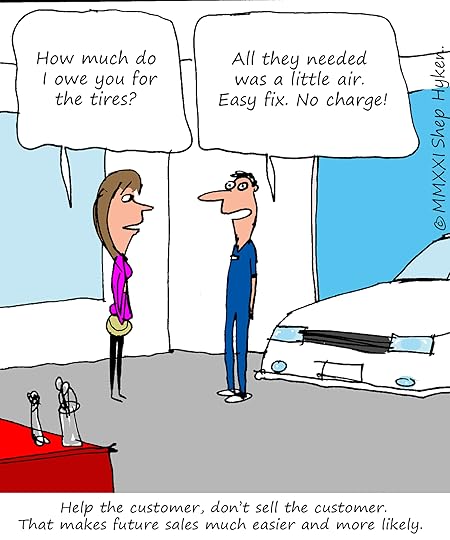 It seems that most of the companies that customers love to do business with have something in common. They focus more on the customer than they do the sale. Sure, they want to make the sale, add more revenue and get higher ratings. What company doesn’t want that? But when they focus on the customer’s needs, the rest seems to fall into place.
It seems that most of the companies that customers love to do business with have something in common. They focus more on the customer than they do the sale. Sure, they want to make the sale, add more revenue and get higher ratings. What company doesn’t want that? But when they focus on the customer’s needs, the rest seems to fall into place.
A great example of this comes from Dawn Mushill, one of our Shepard Letter subscribers. She emailed me a great story worth sharing. The short version is this:
Dawn ordered a product from a vendor. Since she is working remotely, she gave her home address. The company recognized that it would cost more to ship to a residential address and took the time to call her and explain that changing the address could save her money. Her response was, “Wow! Loyalty for future orders!”
It’s important to note that the amount of money she would save was minimal, but the fact that someone from the company reached out to her to offer even a small saving was an unexpected surprise.
Here’s another example. I noticed the tire on my car was almost flat. I took the car to the local repair center. They told me how much a new tire would cost, but before I paid for it, they wanted to see why it was going flat. They called me a couple of hours later to tell me my car was ready. When I showed up to get my car, the bill was just $16. I said, “I thought I needed a new tire.” The manager said, “I thought so, too, but we were able to do a simple repair. Hey, if you want to spend a few hundred dollars on a new tire you don’t need, I guess we can sell one to you.” Of course, he was joking. I was appreciative, and that’s why we keep going back.
So, what can we learn from these examples? Here are six ways to show you care more about your customer than the sale:
Help the customer, don’t sell the customer. That makes the future sale much easier and more likely.When you find ways to save the customer money, even if it’s just a little, it shows you are paying attention to them versus just going through the motions of a transaction.Saving a customer money builds trust. Any company that is trying to save a customer money – sometimes at their own cost – proves they are focused on their customer.An extra interaction, especially when it is focused 100% on the benefit of the customer, is worth the effort. In Dawn’s example, it was to save a little money on shipping. It could be anything, even a check-in call to give the customer an update. And do I need to remind you? No selling.Customers love communication. Keep them updated on the status of an order or problem resolution or any part of the process that takes time. Let them know you still care about them even though you’ve already made the sale.Finally, and this is a good way to summarize what this is all about, it’s not about the money. It’s about the relationship. Build the relationship and the money follows.
Do you have other ways that you show customers you care about them more than the sale? Let me know if you do!
Shep Hyken is a customer service expert, keynote speaker, and New York Times bestselling business author. For information, contact 314-692-2200 or www.hyken.com. For information on The Customer Focus customer service training programs, go to www.thecustomerfocus.com. Follow on Twitter: @Hyken
customer service training programs, go to www.thecustomerfocus.com. Follow on Twitter: @Hyken
(Copyright © MMXXI, Shep Hyken)
The post How to Care More About the Customer Than the Sale appeared first on Shep Hyken.
March 16, 2021
Amazing Business Radio: Neil Baum
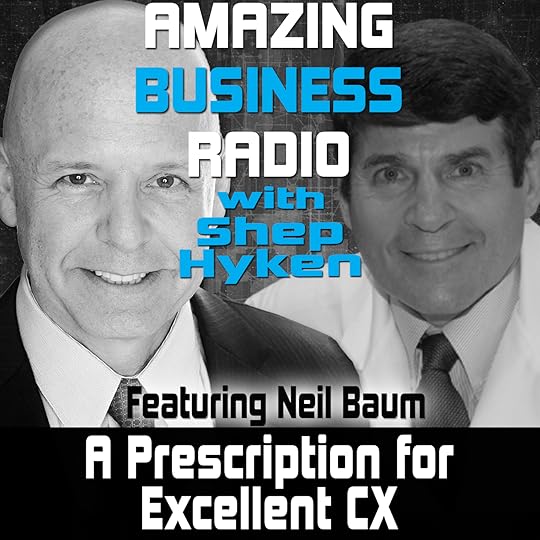 A Prescription for Excellent CXCustomer Service Lessons From the Disney of Healthcare
A Prescription for Excellent CXCustomer Service Lessons From the Disney of HealthcareShep Hyken interviews Neil H. Baum, MD, Professor of Clinical Urology at Tulane Medical School in New Orleans, Louisiana. They discuss some of the foundational concepts in creating an exceptional customer experience.







 Top Takeaways:Some businesses such as a healthcare practice or provider, do not have a product that the customer touches. Instead, it’s all about selling the entire service experience to their customer.Remember to manage the Moments of Truth: any time a customer comes into contact with any part of your business they have the opportunity to form an impression.Words are very powerful in shaping the perception of the customer experience. For example, the waiting room in a doctor’s office could be renamed as the reception area, implying a different experience from just waiting in a room.If your customers are experiencing long wait times or complex systems when trying to call your business, it may be time to hire more help or invest in technology to reduce those hold times or phone trees.Creating a positive customer experience increases the likelihood that your customers will tell others of their experience with you, ultimately making you feel more fulfilled with your work to create that experience.Baum’s 10 Personal Promises to His Patients:We will answer the phone in less than 3 rings.A human, not an answering machine, will speak with you and make your appointment or take your questions.We can usually make an appointment to see you on the same day that you call or the very next day.If you call for the doctor and the doctor is not available, we will call you back the same day and we will tell you what time that call is going to take place.We use an electronic medical record system to send your prescription to the pharmacy immediately so that the medication will be ready by the time you arrive to pick it up.We will send a letter to your primary care doctor or referring physician while you’re still in the exam room that lists your diagnosis, the medications you’ve been prescribed and the treatment plan we’ve outlined for you.We’ll provide you with educational materials on your condition, including articles written by Dr. Baum.You can communicate with me or one of my staff via email and I will answer you usually within the same day.We have a very energetic, enthusiastic and smiling staff who will help exceed your expectations regarding your visit to our office.We will make your visit almost magical.Quotes:
Top Takeaways:Some businesses such as a healthcare practice or provider, do not have a product that the customer touches. Instead, it’s all about selling the entire service experience to their customer.Remember to manage the Moments of Truth: any time a customer comes into contact with any part of your business they have the opportunity to form an impression.Words are very powerful in shaping the perception of the customer experience. For example, the waiting room in a doctor’s office could be renamed as the reception area, implying a different experience from just waiting in a room.If your customers are experiencing long wait times or complex systems when trying to call your business, it may be time to hire more help or invest in technology to reduce those hold times or phone trees.Creating a positive customer experience increases the likelihood that your customers will tell others of their experience with you, ultimately making you feel more fulfilled with your work to create that experience.Baum’s 10 Personal Promises to His Patients:We will answer the phone in less than 3 rings.A human, not an answering machine, will speak with you and make your appointment or take your questions.We can usually make an appointment to see you on the same day that you call or the very next day.If you call for the doctor and the doctor is not available, we will call you back the same day and we will tell you what time that call is going to take place.We use an electronic medical record system to send your prescription to the pharmacy immediately so that the medication will be ready by the time you arrive to pick it up.We will send a letter to your primary care doctor or referring physician while you’re still in the exam room that lists your diagnosis, the medications you’ve been prescribed and the treatment plan we’ve outlined for you.We’ll provide you with educational materials on your condition, including articles written by Dr. Baum.You can communicate with me or one of my staff via email and I will answer you usually within the same day.We have a very energetic, enthusiastic and smiling staff who will help exceed your expectations regarding your visit to our office.We will make your visit almost magical.Quotes:“The customer experience begins with the patient, or customer, the moment you start any sort of interaction.”
“One piece of advice for anybody who is in business is to be on time and to respect the other person’s time.”
About:Neil H. Baum, MD, Professor of Clinical Urology at Tulane Medical School, has written over 300 peer-reviewed articles and 10 books on marketing, communications between doctors and patients, as well as publications on men and women’s healthcare issues. Dr. Baum is the also author of The Business Basics to Building and Managing a Healthcare Practice which was published in 2019.
Shep Hyken is a customer service and experience expert, New York Times bestselling author, award-winning keynote speaker, and your host of Amazing Business Radio.
This episode of Amazing Business Radio with Shep Hyken answers the following questions … and more:
What are the basics of good customer service?How do you create customer loyalty?How can you reduce friction for your customers?What can other service industries learn from the healthcare industry?How can you enhance the customer experience?The post Amazing Business Radio: Neil Baum appeared first on Shep Hyken.
March 15, 2021
5 Top Customer Service Articles For the Week of March 15, 2021
Each week I read a number of customer service and customer experience articles from various resources. Here are my top five picks from last week. I have added my comment about each article and would like to hear what you think too.
How to Deliver Memorable Customer Experiences in a Post-Pandemic World | We Are Forever Changed by Joseph Michelli
(Joseph Michelli) The art of post-pandemic experience creation will be to select relevant technology-aids accompanied by engaging human interactions and assume that COVID-19 has forever changed experience delivery. For this short post, let’s look at two emerging customer experience trends
My Comment: When Joseph Michelli writes an article about customers or experience, it is a “must-read.” This article approaches the very timely topic of the experiences we plan to deliver in a post-pandemic world. The gist of the article focuses on trust and human-to-human interaction.
12 Golden Rules for Customer Experience Strategy by Steven van Belleghem
(Entrepreneur) Each and every company is, of course, different, but there are some essential ingredients that, if executed well, combine to create a level of service that customers will truly love.
My Comment: And here is another one of my favorite customer experience experts, Steven van Belleghem, sharing a dozen excellent tips to deliver a better CX. He refers to these as twelve “golden guidelines.” They all make sense and many of them are relevant for almost all businesses in any industry.
Interview: Creating a Clean Experience by Jim Tincher
(Heart of the Customer) How would you respond if your deliberately behind-the-scenes customer experience efforts were suddenly thrust to the foreground?
My Comment: Here is an interesting article – actually an interview – featuring Todd Hopkins, a successful franchisor, who recognizes the value of creating an excellent customer experience, or as he calls it, a “clean Experience.” There’s some excellent wisdom in his comments that we should all take note of.
How to Calculate Your Customer Retention Rate by Max Freedman
(Business News Daily) Knowing your customer retention rate and some strategies to improve it can help you boost your bottom line.
My Comment: We all want repeat customers. I just wrote another book (I’ll Be Back: How to Get Customers to Come Back Again and Again), which is all about repeat customers. So, how do you calculate your customer retention rate? Here’s the article that includes the formula you need. In addition to the formula, the author includes several ways to boost retention.
Customer service training needs to be on your short-term bucket list by Shaun Belding
(Shaun Belding) Organizations around the world have been scrambling to capture some of this magic. Most aren’t succeeding. Those that are, while seeing impressive gains in profitability, are no longer achieving the lightning-in-a-bottle results of the above role models.
My Comment: This article makes the point that customer service training is important, but even more important than that are some of the author’s comments. Consider that customer experience is no longer a differentiator. It’s the price of admission. (SPOT ON!) And, that customer service drives loyalty, not automation. Also included are five signs that you are ready for more customer service training.
BONUSESTPD officers go viral after captured on camera gifting man a mobility scooter by New 4 Tucson
(New 4 Tucson) Two Tucson Police Department officers went above and beyond their duties after they were seen gifting a mobility scooter in a heart-warming video shared Wednesday.
My Comment: Put this one into the “Feel Good” category. It caught my eye because it concluded one of my quotes about recognizing that every interaction is an opportunity to make a positive impact on others. In this case, it was two Tucson Police Department officers gifting a mobility scooter to an older gentleman. It includes a short video. #BeNice!
10 CX Thought Leaders You Need To Follow to Stay In Tune With The Pulse Of The Industry by Othmar Mueller Von Blumencron
(VIPDesk Connect) We have compiled a list of some of our favorite thought leaders and trend setters in the Customer Service industry.
My Comment: I’m honored to have made another list of CX thought leaders to follow. Thank you VIP Desk for this honor. There are some rock star CX leaders. If you aren’t reading their work, listening to their podcasts or connected with them on their social channels, you’re missing out on some great content.
 Shep Hyken is a customer service expert, professional speaker and New York Times bestselling business author. For information on The Customer Focus
Shep Hyken is a customer service expert, professional speaker and New York Times bestselling business author. For information on The Customer Focus customer service training programs go to www.TheCustomerFocus.com. Follow on Twitter: @Hyken
customer service training programs go to www.TheCustomerFocus.com. Follow on Twitter: @Hyken
The post 5 Top Customer Service Articles For the Week of March 15, 2021 appeared first on Shep Hyken.
March 12, 2021
Guest Post: Reset Buyer Strategy to Drive Post-Pandemic Revival
This week we feature an article from Rohan Malkotia, Digital Marketing Executive at Servetel. He writes about how businesses need to realign their sales and marketing strategies in order to survive a post-pandemic world.
The pandemic has brought everyone back to basics. Budgets have run tight, making buyers selective about what they pick. Needless to say, luxuries of life have been replaced by the ‘must-have’ items.
The impact extends from B2C (business-to-customer) markets to B2B (business-to-business) sales as well. Many sales and marketing experts state that the current phase is the most challenging one they have faced thus far.
This has led to a paradigm shift in working styles for businesses of all scales and sizes. A study by McKinsey Consulting in April 2020 indicated that digitally-enabled sales interactions were at least twice more important during the pandemic than they were in the pre-COVID-19 era. That’s not surprising given that sales teams have been unable to physically interact with the potential clients at this point.
Navigating through such uncertain circumstances, companies must remember that they can only survive and thrive by realigning their sales and marketing strategies. The key lies in completely resetting the overall buyer strategy according to evolving buyer behaviors.
Before we process to discuss the realignment, let us first understand what buyer strategy is all about, specifically with respect to B2B customers.
Understanding Buyer StrategyEssentially, buyer strategy refers to the solutions and integrations that need to be implemented by a business to enable its buyers to achieve their goals. There are three basic elements to it––goals, solutions, and interactions. All these elements need to be realigned for a post-pandemic reset.
Here are some insights into how COVID-19 has influenced each of these elements.
Buyer goals are no longer the sameThe pandemic’s impact on buyer expectations and goals has been immense. It has drastically changed their spending capacity and habits. Businesses that don’t take note of these behavioral modifications will experience a severe misalignment with sales strategies.
They may end up losing a lot of customers, and thereby, revenue opportunities. Thus, they must approach current buyer goals with a fresh perspective for product development, growth strategies and tapping new markets.
Technology solutions are the need of the hourInnovation remains the answer to most obstacles that lie in the journey ahead. Every business needs to offer novel solutions to close high-value B2B deals with confidence, even if they haven’t seen the products in-person or aren’t visiting the seller’s place.
With air travel, in-person meetings and conferences curtailed right now, it is the only way businesses can sail through the pandemic revival stage.
Consumer interactions have changed as wellMost employees have moved to the work-from-home set-up. B2B companies, too, are embracing it as a norm, and the trend is likely here to stay for a long while.
Ever since technology has become a part of remote selling, consumer interactions have witnessed a massive disruption. No longer can they drop in physically with their queries and concerns. All communication must, instead, take place digitally––even self-service.
These interactions will have to be redesigned, in order to be more realistic and seamless in the post-pandemic world.
Actionable Steps for ResetNow that we have a better understanding of these elements, it makes sense to go through the practical aspects of resetting them. Here are some actionable steps that any business can take to get itself ready for the post-pandemic sales scenario.
Increasing online prospects, lead generation and salesRe-prioritisation of inbound programs should be top of the list as the economy slowly gets back on its feet. The best approach would be to increase online prospecting, lead generation and sales.
Investing in an aggressive digital marketing plan is the best way to go. Consider implementing result-oriented tactics like pay-per-click and account-based marketing for quick, effective and sustainable outcomes.
Accelerating connectivity through technologyTechnology isn’t a disruptive force in B2C retail only, a sector that has seen a massive e-commerce shift. It has a lot to do in the B2B landscape as well as it connects business with customers in the era of social distancing.
Your leads and customers have become totally comfortable with remote buying and self-service for support requests. Now is the right time to invest in conversational technologies and stay a step ahead on the communication front. Unless your sales team is available for personalized interactions, you are not ready with a reset for your buyer strategy.
Aligning marketing and salesThe line between marketing and sales has always been a thin one, and now is the time to blur the minute difference. An alignment of both the departments is the need of the hour for B2B businesses. These teams working in sync can make your inbound program a success.
But doing so is easier said than done. It will take considerable effort to get both the teams on the same page and ensure that they work towards common goals to always keep the sales pipeline stocked with qualified leads.
Going the extra mileEven though you may want to increase your customer base during the revival phase, retaining the loyal ones is vital to sustenance. Businesses must keep in mind that they can easily lose their existing customers in the chaos that has ensued over the past few months.
The only way to prevent this from happening is by going that extra mile to strengthen existing relationships. This makes inbound an ideal approach as it leverages campaigns and segmentation to serve current customers in the best possible manner.
Happy customers are more likely to stay with the business and also recommend it to others. With the immense potential of word-of-mouth marketing in the B2B landscape, retention is something you cannot overlook.
Knowing your buyer betterPerhaps the most important aspect of keeping pace with buyer strategy is knowing your customers better. Extensive consumer research is a worthwhile investment in this regard as it offers insights into how customers’ goals have changed.
Further, refreshing your customer personas and journey mappings is a good idea. You may also consider taking a hit-and-trial approach by designing and redesigning buyer interactions mapped to their goals. Innovation in customer enablement is also another way to stay ahead.
Final WordsLooking ahead into the post-pandemic era, B2B companies need to make serious efforts to reset their buyer strategies. It is possible only with an in-depth insight into the impact of COVID-19 on consumer behavior and expectations.
Also, enabling them with the right technologies that drive seamless interactions with your sales and customer support teams is equally important. Although it may require some investment, this is the only way you can take your business on the road to post-pandemic recovery and revival.
Rohan Malkotia is an experienced Digital Marketing Executive with a demonstrated history of working in the telecommunications industry. Rohan is skilled in Search Engine Optimization (SEO), Pay Per Click (PPC), Email Marketing, Conversion Optimization and Social Media Marketing.
F
 or more articles from Shep Hyken and his guest contributors go to customerserviceblog.com.
or more articles from Shep Hyken and his guest contributors go to customerserviceblog.com.
Read Shep’s latest Forbes article: Leadership Actions to Take During the COVID-19 Pandemic
The post Guest Post: Reset Buyer Strategy to Drive Post-Pandemic Revival appeared first on Shep Hyken.
March 10, 2021
Culture is Contagious
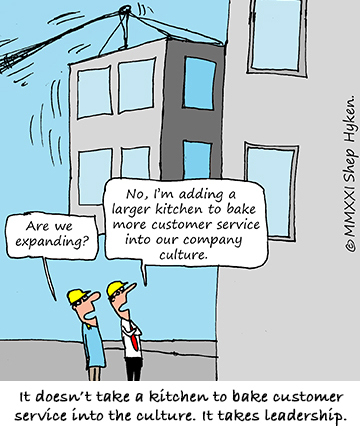 I was recently interviewed by Yigal Adato for his mastermind group, all entrepreneurs and owners of pawnshops. We were discussing how important it is to “bake” customer service into the culture.
I was recently interviewed by Yigal Adato for his mastermind group, all entrepreneurs and owners of pawnshops. We were discussing how important it is to “bake” customer service into the culture.
It’s leadership’s job to define the customer service vision, ensure it’s communicated, and be the role models demonstrating how customers and employees are to be treated.
In addition, leadership and management must defend the culture. If any part of the team isn’t in alignment with the customer service vision, be it an individual or a department – or even an entire region for larger companies – they need to be coached and properly trained. Everybody needs to be headed in the same direction and delivering a certain level of service to both internal and external customers. It’s not just in the culture, it’s a philosophy to be embraced by everyone in the organization.
And don’t think customers won’t notice. They will. And, when they talk to one person in your organization who is out of alignment, do you know what they think? They think everyone in the company is like that one person who isn’t delivering the typical experience you want your customers to experience.
At some point, Yigal said, “So, the culture is contagious.”
BOOM! That’s it! That is a great summary statement. In the best-run companies, the culture is contagious – for both the employees and the customers. Unfortunately, it’s also contagious in the worst-run companies.
It must be abundantly clear how you define customer service and experience in your organization. Everyone must know the role they play in delivering on that definition. To make it part of the culture, and to be contagious, it must be introduced during the hiring process, heavily trained in the onboarding of new employees, and consistently communicated and reinforced on a regular basis for sustainability.
The culture of your organization is what defines everything about your company. Think of some of the great recognizable brands and how they make you feel. Is it congruent with how employees act toward customers and each other? I remember the first time I stayed at a Hard Rock Hotel. I was excited to stay in this hip, cool, trendy hotel. Just like the restaurants have music memorabilia hanging on the walls, so do the hotels. I was fascinated by the environment. Rock music was piped in through the hotel. Employees walked around, bouncing to the beat of the music. Before long, I was doing it, too. Yes, their culture is contagious!
It’s simple, but that doesn’t mean it’s easy. The culture must be clearly defined. Employees must understand it. They must be trained to it. They must buy into it. They must live it. And they must love it. That’s how you begin to create a culture that is contagious.
Shep Hyken is a customer service expert, keynote speaker, and New York Times bestselling business author. For information, contact 314-692-2200 or www.hyken.com. For information on The Customer Focus customer service training programs, go to www.thecustomerfocus.com. Follow on Twitter: @Hyken
customer service training programs, go to www.thecustomerfocus.com. Follow on Twitter: @Hyken
(Copyright © MMXXI, Shep Hyken)
The post Culture is Contagious appeared first on Shep Hyken.
March 9, 2021
Amazing Business Radio: Christine Trippi
Shep Hyken interviews Christine Trippi, CEO at The Wise Pineapple. They discuss the value in empowering your employees to provide the best experience possible for your customers.







 Top Takeaways:The secret to getting your employees to love coming in to work is creating an environment where employees feel welcome, loved and empowered.One of the most important things you can do every day is huddle with your team. Meet together and talk about your culture and company values daily.The number one reason people leave their jobs is because they are not feeling recognized or valued by their boss or management.Keeping a healthy, productive company culture is all about making sure your employees feel valued, informed of their responsibilities, participate in ongoing training, and set goals to help them grow.The anxiety from having to confront customers on a hard “no” can cause employees to enter their fight or flight mode. Either way, the interaction becomes negative and causes the customer to become even more unhappy with the situation.Find ways to say yes to your customers, even if the answer is no.Christine Trippi’s four-step process on how to always say yes includes: 1) Make friends first. 2) Explain what you can do. 3) Offer options. 4) Be creative.Energy times execution equals your sweet results. After feeling inspired you may have a lot of energy to get started, but it’s the ideas and the execution of those ideas that will make sweet success.Quotes:
Top Takeaways:The secret to getting your employees to love coming in to work is creating an environment where employees feel welcome, loved and empowered.One of the most important things you can do every day is huddle with your team. Meet together and talk about your culture and company values daily.The number one reason people leave their jobs is because they are not feeling recognized or valued by their boss or management.Keeping a healthy, productive company culture is all about making sure your employees feel valued, informed of their responsibilities, participate in ongoing training, and set goals to help them grow.The anxiety from having to confront customers on a hard “no” can cause employees to enter their fight or flight mode. Either way, the interaction becomes negative and causes the customer to become even more unhappy with the situation.Find ways to say yes to your customers, even if the answer is no.Christine Trippi’s four-step process on how to always say yes includes: 1) Make friends first. 2) Explain what you can do. 3) Offer options. 4) Be creative.Energy times execution equals your sweet results. After feeling inspired you may have a lot of energy to get started, but it’s the ideas and the execution of those ideas that will make sweet success.Quotes:“A lot of companies have a great onboarding process that covers their missions and values, but then it ends on day one. It’s how you pull through every day that’s going to create your company culture.”
“The number one reason people leave their jobs is because they don’t feel recognized or valued by their company. Not because they want more money.”
“Recognize and value your team, give them information to do their job well, train them, and give them ways to win every day. That’s how you keep a healthy company culture.”
“Energy times execution equals sweet results. You can get excited about implementing new ideas, but you must execute those ideas to have success.”
About:Christine Trippi is an award-winning hotelier who has been in a romance with hospitality for over 30 years, serving as manager at resorts, and full and select-service hotels. She is the founder of The Wise Pineapple and uses her experience and passion for helping leaders and organizations haveSweet Operations, Sweet Cultures, and Sweet Results.
Shep Hyken is a customer service and experience expert, New York Times bestselling author, award-winning keynote speaker, and your host of Amazing Business Radio.
This episode of Amazing Business Radio with Shep Hyken answers the following questions … and more:
How do you empower your employees?How do you create a healthy company culture?How do you say no to your unhappy customers?What skills can you learn from the hospitality industry?Why is it important to empower your employees?The post Amazing Business Radio: Christine Trippi appeared first on Shep Hyken.
March 8, 2021
5 Top Customer Service Articles For the Week of March 8, 2021
Each week I read a number of customer service and customer experience articles from various resources. Here are my top five picks from last week. I have added my comment about each article and would like to hear what you think too.
Why marketing can no longer ignore customer experience by Jason VandeBoom
(Digiday) Customer experience is rapidly becoming more designable, more accessible and more creative. It is also impossible to ignore its importance to marketing. Experiences are what people buy, what people remember and what people talk about. They are fundamental to the product and the way it is promoted. They build brands.
My Comment: Customer Experience (CX) is marketing. It’s that simple. Creating an experience that drives people to your website, your store, or willing to meet with a sales representative is all part of marketing. We want to move people to buy. Then once they do, we want to continue to create experiences that bring them back. Automation and technology can play an important role in that strategy. Here’s an article by Jason VandeBoom, CEO of ActiveCampaign, on how to use automation to deliver a better CX.
16 Tips For Boosting Customer Satisfaction With Happier Employees by Forbes Coaches Council
(Forbes) 16 members of Forbes Coaches Council shared their best tips for business owners to start improving customer satisfaction with happier employees.
My Comment: The beginning of a good customer service and experience strategy starts on the inside with the company’s culture. Happier employees will mean happier customers. Here are 16 members of the Forbes Coaches Council sharing their tips on how to motivate and engage employees to create a better experience for customers.
598 hoteliers share their best tips for boosting revenues in times of crisis by Tony Loeb
(Hospitality.com) Recently, we sent a survey to thousands of your colleagues, with two goals: to ask them about the major changes the sector experienced in 2020 and to find out what key actions they are taking as we start a new year.
My Comment: If you’ve been following me, you know that I’m a big believer in the hospitality mentality. It doesn’t matter what type of business you are in, any company can learn from the hotel and restaurant industries, where a lack of hospitality could send you toward going out of business. This is more of an infographic than an article, but there are some very interesting stats and facts about what thousands of hoteliers are doing to survive in a crisis (a.k.a. pandemic).
Singapore Airlines Opens a Customer-Service School for Businesses by Katie Deighton
(The Wall Street Journal) Carrier’s new division plays into HR leaders’ growing interest in learning and development amid the pandemic.
My Comment: Want to learn customer service from the best? You could hire the training professionals at Ritz-Carlton, Disney, Zappos, and even our company, The Customer Focus. Introducing a newcome to the list, Singapore Airlines. They have the reputation for being one of the best airlines in the world. Now they teach the world exactly how they do it.
Through the Eyes of the Customer: Ideal Customer Experience in 2021 [eCommerce and Beyond] by Casimir Rajnerowicz
(TIDIO) We surveyed 1,000+ online shoppers in the US to probe into the latest customer experience trends. Dive into our original customer service statistics for 2021.
My Comment: Here is a fascinating study of online shopping behavior. It is full of stats from a very robust survey, heavily weighted to one of the most influential groups of customers, Gen Z.
Shep Hyken is a customer service expert, professional speaker and New York Times bestselling business author. For information on The Customer Focus customer service training programs go to www.TheCustomerFocus.com. Follow on Twitter: @Hyken
customer service training programs go to www.TheCustomerFocus.com. Follow on Twitter: @Hyken
The post 5 Top Customer Service Articles For the Week of March 8, 2021 appeared first on Shep Hyken.
March 5, 2021
Guest Post: 5 Tools to Uplift Your Store’s Customer Experience
This week we feature an article from Deb Mukherjee, a SaaS marketer with DelightChat. He shares five customer-related applications worthy of taking your eCommerce customer service to the next level.
In this day and age, eCommerce is a booming industry. The global eCommerce market size was valued at 9.09 trillion dollars in 2019. As we’re still embracing remote work and social distancing, folks would be purchasing from online stores.
As you might be aware, BFCM days indicate to eCommerce business owners how the next year will be in sales. Well, they have reason to rejoice. According to Shopify, Shopify store owners collectively made USD 5.1 billion in sales between Black Friday and Cyber Monday globally, up 76% from last year.
To increase your store’s sales, the customer experience of the store must be top-notch. What’s customer experience? It’s the experience that your customer would go through right from when they enter your online store to purchasing a product.
It’s not easy to uplift your store’s customer experience. It’s an incremental process that takes time and focus. However, some Shopify apps will make your life easier and complement your efforts.
Let’s look at these 5 Shopify apps that will help you boost your store’s customer experience effortlessly:
PrivyPrivy Convert accelerates your email list growth through timely popups, flyouts, and onsite displays. With Privy, you can capture the visitor’s email and leverage that for various personalized campaigns like cart abandonment, special discounts, etc.
Since you have the customer’s email, you can have a 1:1 conversation with them, thus enabling you to receive first-hand feedback. It also shows that you care for your customers, which in turn uplifts your customer experience.

Privy Convert allows you to use the product for free but with a cap of 5,000 pageviews on the store. Post that, you pay $20/month for 10,000 pageviews.
KlaviyoKlaviyo is an email marketing automation software that caters to eCommerce businesses. With Klaviyo, you can send cart abandonment emails, execute generic email campaigns at scale, and send highly personalized emails to specific customers based on their purchase history.
With hyper-personalization and segmentation of your emails, you build a close relationship with your customers. The fact that the product recommendations are personalized goes a long way to establishing a long-term relationship. This directly enhances the overall customer experience of the store.

Klaviyo offers a free plan, but 250 contacts limit it. From the 251st contact, you pay $20/month.
DelightChatDelightChat is a customer support software for eCommerce brands. With its omnichannel support inbox, you can respond to customer queries from every channel on one screen. You never have to switch back and forth browser tabs.
With on-time customer service, you might see a backlash from your customers and might switch to buying from your competitors. A tool like DelightChat enables you to manage customer support seamlessly. And as you’ve probably guessed, it improves the experience as you’re serving them after they’ve purchased from your store.
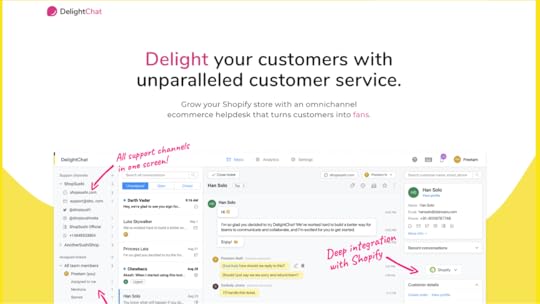
DelightChat is currently free if you sign-up for the beta. It will be reasonably priced when it’s launched to the public.
LooxLoox helps you add visual social proof to the product pages on your eCommerce store. It allows you to send automated emails that ask your customers for reviews. Every time they review the product with an image, you can use that opportunity to incentivize them (like sharing a unique discount code).

They’ve got a free trial of 14 days, but then the lowest plan starts at $9.99/month for 100 monthly review request emails.
LoyaltyLionLoyalty programs put a smile on your customers’ faces. They can also aid with an increase in revenue and create brand advocates. That’s where LoyaltyLion can assist your eCommerce business. With LoyaltyLion, your customer can accrue points on every purchase, social share, or newsletter sign-up and later use them as a discount on your store.
It creates an extraordinary customer experience. You’re giving them a discount, but instead of a direct one, they can collect points and convert it into a value or some other benefit. This produces stickiness for your products & also creates raving fans.
Social proof is a big part of an excellent customer experience. A visitor will look at authentic, first-hand reviews to inform their purchase decision. This equips the customer to make the right choice.
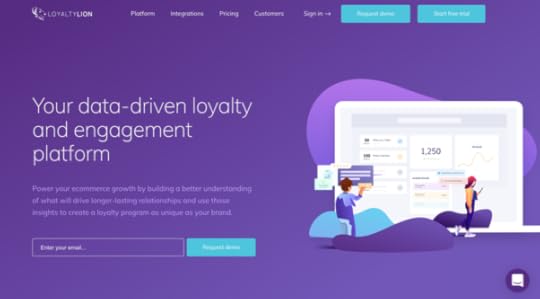
LoyaltyLion starts at $399/month for 2000 customers. They’re on the expensive side, but you can try out the product for free for 14 days.
Ending NotesIn 2021, customer experience will play a key role in determining which eCommerce businesses succeed, given the number of options in every category. It’d be prudent to invest a part of your efforts to improve your store’s customer experience.
Deb Mukherjee is a SaaS marketer with 5+ years of working with companies across the globe. He has consulted over 40 companies to date and is now heading the marketing function at DelightChat, a customer support software for eCommerce & DTC companies.
F
 or more articles from Shep Hyken and his guest contributors go to customerserviceblog.com.
or more articles from Shep Hyken and his guest contributors go to customerserviceblog.com.
Read Shep’s latest Forbes article: The Impact of the Remote Workforce
The post Guest Post: 5 Tools to Uplift Your Store’s Customer Experience appeared first on Shep Hyken.
March 3, 2021
How to Handle Lost Luggage: A Lesson From the Airlines
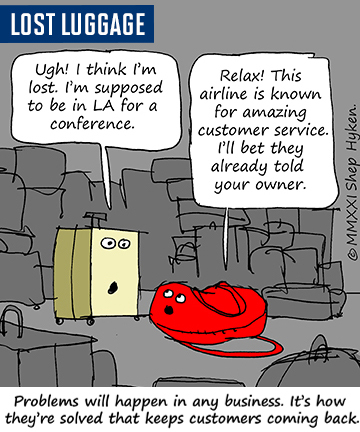 It’s been almost a year since my last business trip. I’m excited as I’m writing this article because I’m about ready to take the first trip since the COVID-19 lockdown.
It’s been almost a year since my last business trip. I’m excited as I’m writing this article because I’m about ready to take the first trip since the COVID-19 lockdown.
I reflected on what I love about travel, and even some of what I don’t love. Falling into the latter category of what I don’t love is checking luggage. I’m not sure if there is a term for this phobia, but I have the fear of airlines losing my luggage. Many of us “road warriors” choose to be “luggage minimalists” and pack everything into one small piece of luggage that fits in the overhead. If the trip is under seven days, I can usually do it.
My memory of the few times my luggage was lost by the airlines includes waiting until I’m the last guy standing at the baggage carousel. Then, realizing my luggage is lost, I head over to the baggage office where I wait behind a bunch of other people who have the same problem. None of us in that office are happy to be there. The anger and hostility toward the airline – and unfortunately toward the person working the counter for the airline – can be felt in the air.
Apparently, those were the old days. My last lost luggage experience was more pleasant. So much so, that even though I was upset about the lost luggage, the way the airline handled was a pleasant surprise. Here’s what happened.
Once the plane landed and I turned my cell phone on, there was a text message from the airline informing me that my luggage didn’t make my flight and would be on the next flight. The message also asked me to text back the address where I would be staying, and they would deliver the bag within a few hours after the flight landed. They also gave me a number to call with any questions.
While I wasn’t happy with losing my luggage, I was happy I didn’t have to wait at the baggage claim carousel to find out and then deal with the line. Messaging is apparently the new way to deal with lost luggage. Furthermore, throughout the day I was sent updates from the airline until the luggage finally arrived that day. Of course, they sent me a final message confirming the luggage was delivered.
I realize that sometimes the luggage is really lost. Even the airline might not know where it is. But, most of the time this is their new way of managing the passenger’s experience, I like it. Here’s what we learned:
Be Proactive – When you know there’s a problem, let the customer know right away.Apologize – You must always do this!Explain the Resolution – Let the customer know what you’re going to do to resolve the problem.Constantly Update – Don’t be afraid to give too much information. Customers love information and updates about problems they are waiting to get resolved.Finish Clean – When the problem is finally resolved, send one last message to close out the experience and thank the customer, once again.Problems will happen in any business. In some cases, customers are happy to come back. Why? It’s not just that the problem was resolved. It’s the way it was resolved.
Shep Hyken is a customer service expert, keynote speaker, and New York Times bestselling business author. For information, contact 314-692-2200 or www.hyken.com. For information on The Customer Focus customer service training programs, go to www.thecustomerfocus.com. Follow on Twitter: @Hyken
customer service training programs, go to www.thecustomerfocus.com. Follow on Twitter: @Hyken
(Copyright © MMXXI, Shep Hyken)
The post How to Handle Lost Luggage: A Lesson From the Airlines appeared first on Shep Hyken.





